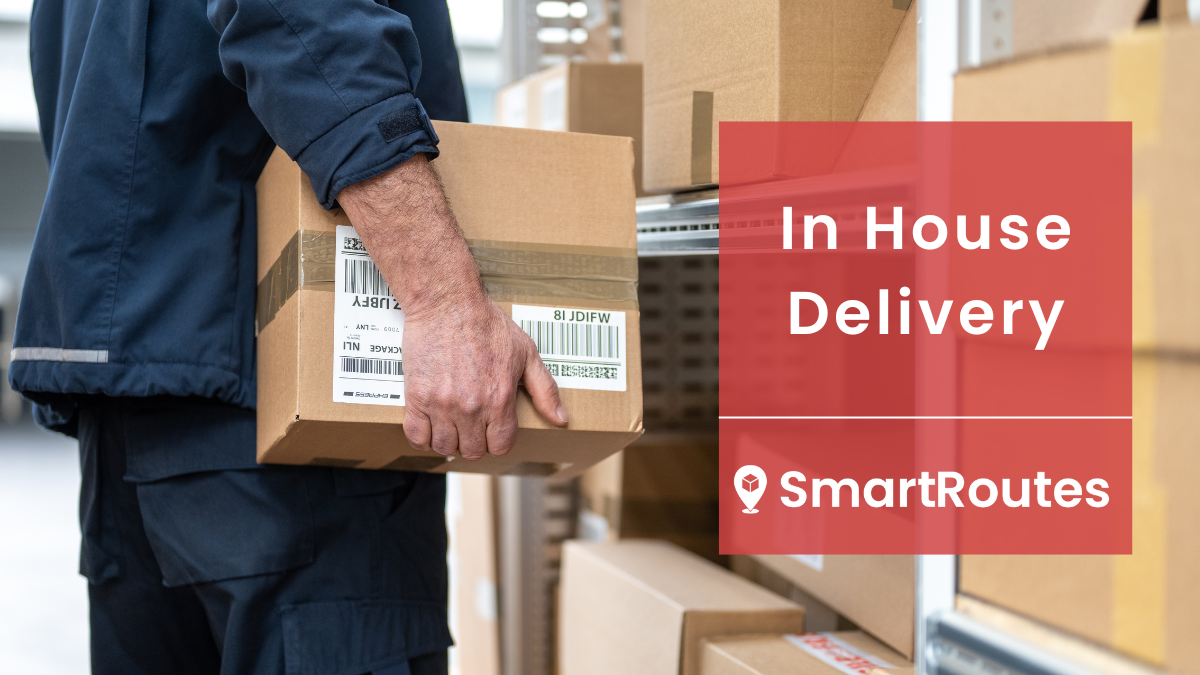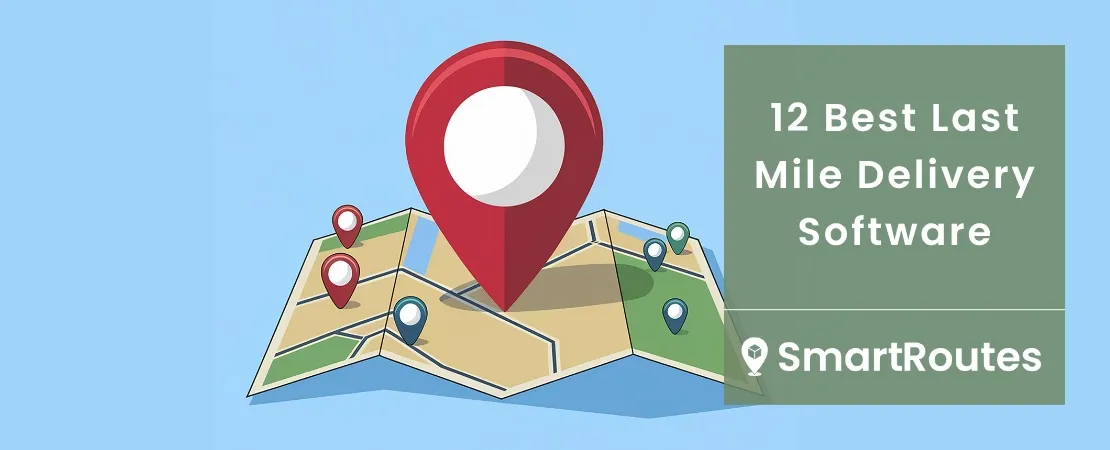Quick Summary
- Last mile delivery software helps businesses streamline last mile logistics, cut fuel costs, and enhance customer communications.
- This 2025 guide compares the leading last-mile delivery management platforms, including pricing, key features, and performance analytics.
- Entry-level packages start at $29 per vehicle per month, with scalable options for larger delivery fleets.
- Choosing the right solution depends on fleet size, delivery volumes, delivery times, and the level of visibility and customer notifications required.
With dozens of last-mile delivery platforms available, selecting the right solution can be challenging for any business.
The right solution does more than just route optimization; it helps cut fuel costs, manage delivery windows, track drivers with real-time tracking, and ensure smooth proof of delivery to improve customer experience.
Whether managing a small fleet, a mid-sized operation, or a large-scale last mile logistics network, the right software can make a huge difference to how your business operates.
How to Evaluate Last Mile Delivery Software
Choosing the right last mile delivery platform can be overwhelming, especially when balancing delivery volumes, fleet size, and operational efficiency.
To simplify the process, focus on the features that impact delivery performance, customer satisfaction, cost per delivery, and overall logistics operations.
Route Optimization
Route optimization is a core component of last mile logistics software.
The right software should be able to handle multiple depots, different vehicle capacities, and delivery time windows. All while dynamically adjusting routes based on real-time traffic and operational changes.
The result? Reduced fuel costs, fewer delivery delays, and more deliveries completed per shift. Advanced algorithms and AI-powered route optimization can further improve route planning efficiency and reduce cost per delivery.
SmartRoutes Route Planning Software
Streamline your entire delivery process, all from one platform

Real-Time Tracking
Real-time tracking provides visibility for both dispatchers and customers.
Dispatchers can monitor driver locations and progress on a live map, while customers receive accurate ETAs and updates.
This transparency enhances delivery performance and significantly improves customer retention, resulting in a reduction in inbound delivery inquiries.
Proof of Delivery
Last mile software should include robust proof of delivery features.
Look for platforms that capture electronic customer signatures, photos, barcodes, and delivery confirmation images.
A digital POD system should sync with warehouse management systems, ERP systems, or CRMs to ensure accurate record-keeping, reduce disputes, and maintain accurate records of completed deliveries.
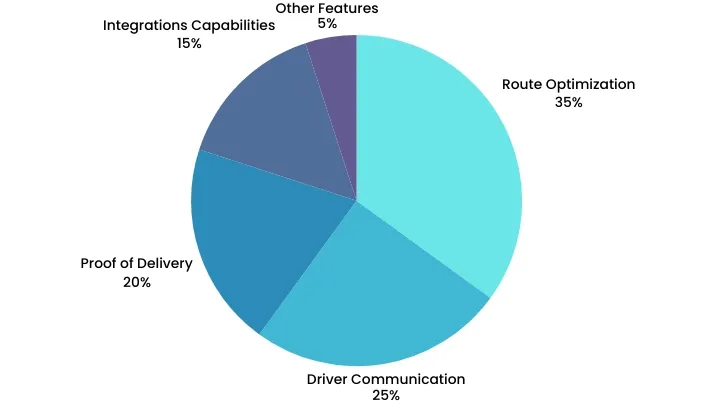
Driver App
A comprehensive driver app is essential for delivery fleet management.
Mobile driver apps should be intuitive, work offline, and allow drivers to update delivery statuses, follow optimized route planning, and capture PODs on hand-held devices.
Driver apps also improve delivery performance, reduce errors, and enable automated dispatching.
Integrations
Top platforms offer robust integration capabilities, connecting seamlessly with eCommerce platforms, warehouse management systems, inventory management tools, and transportation management systems.
API access allows businesses to create custom workflows, automate logistics processes, and improve last mile delivery metrics.
12 Best Last Mile Delivery Software
Whether you’re a small startup just getting started with route optimization software or a large enterprise managing hundreds of deliveries per day, these reviews will help you identify the solution that fits your needs.
1. SmartRoutes
Best for: Delivery businesses of all sizes seeking a complete delivery management solution
SmartRoutes has built a reputation as one of the most versatile last mile delivery platforms on the market.
It combines route planning, customer notifications, and proof of delivery into one easy-to-use system.
For teams managing a delivery fleet day in and day out, the combination of a clear desktop dashboard and an intuitive driver app makes operations far smoother.
What sets SmartRoutes apart is how it handles customer communication. Automated updates, real-time tracking links, and digital delivery confirmations are included as standard. Drivers can capture photos, signatures, and notes through the app, which are instantly synced back to dispatchers.
Another strength is its flexibility with integrations, connecting easily to eCommerce platforms and CRMs so businesses don’t have to juggle multiple tools.
Key Features:
- Route Optimization: Calculates the most efficient routes based on traffic, delivery windows, and package priorities.
- Real-Time Delivery Tracking: Provides customers and dispatchers with up-to-date delivery status through tracking links or portals.
- Electronic Proof of Delivery: Captures photos, e-signatures, and other confirmations to verify deliveries and reduce disputes.
- Delivery Notifications: Sends automated SMS and email alerts to inform customers of delivery timing and details.
- Driver and Customer Communication: Facilitates seamless interaction between drivers, dispatchers, and customers via in-app, SMS, or email updates.
- Integrations: Connects with CRMs, ERP systems, e-commerce platforms, and other business software to streamline logistics processes.
Pricing
Packages start at $29 per vehicle per month, with scalable options for larger fleets. A 7-day free trial is available for businesses that want to test the platform before committing.
At a glance: SmartRoutes is a strong choice for businesses that want an all-in-one solution for delivery operations. Its balance of simplicity, advanced features, and integrations make it a good fit whether you’re managing a few vehicles or a larger delivery fleet.
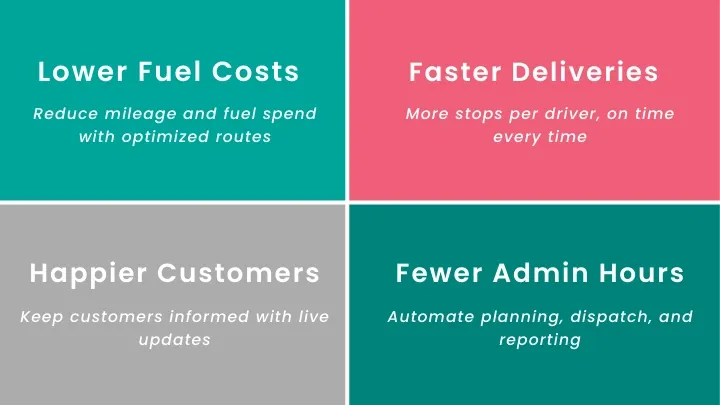
2. RouteXL
Best for: Small or new businesses seeking a free or low-cost route optimization tool
RouteXL is a straightforward route planning solution aimed at smaller delivery businesses that want to improve efficiency without investing in complex software.
Its simplicity makes it ideal for teams managing fewer vehicles or lower delivery volumes, helping to reduce travel time and fuel costs while maintaining reliable last mile logistics.
While it lacks advanced features like real-time tracking or POD capture, RouteXL covers the essentials for optimizing delivery routes and ensuring timely deliveries, making it an excellent starting point for small businesses or startups.
Key Features:
- Route Optimization: Automatically calculates efficient routes to minimize travel time and fuel costs.
- Free Version: Supports up to 20 stops per route at no cost.
- Flexible Paid Plans: Daily subscriptions allow unlimited stops for just $5, giving small businesses flexibility as they grow.
Pricing
RouteXL is free for routes with up to 20 stops. For larger delivery volumes, paid plans allow unlimited stops at a daily subscription of $5, offering an affordable option for small delivery fleets.
At a glance: RouteXL is ideal for small businesses or new delivery operations that need a simple, cost-effective route planner app. It provides basic delivery management without the complexity of enterprise solutions.
3. Spoke (formerly Circuit)
Best for: Businesses seeking a seamless mobile app experience for deliveries
Spoke (formerly Circuit) has become popular among couriers for its intuitive and reliable mobile app.
Designed to save drivers time and streamline delivery routes, it functions like a turbo-charged navigation tool tailored specifically for multi-stop deliveries.
The platform helps reduce fuel costs, minimize delivery delays, and supports last mile logistics for small to medium fleets.
While Spokes desktop ‘Spoke Dispatch’ is available, it is lighter on advanced customization, making the mobile app the standout feature for driver-focused operations.
Key Features:
- Route Optimization: Calculates efficient multi-stop delivery routes to save time and reduce fuel consumption.
- Mobile App: User-friendly and intuitive for drivers, with real-time updates and offline capabilities for areas with weak signal.
- Delivery Management: Track stops, adjust routes, and monitor driver progress seamlessly from the app.
- Customer Notifications: Optional updates keep customers informed, improving customer satisfaction and communication.
Pricing
Plans start at $100 per month for up to 500 stops and $200 per month for 1,000 stops, offering reliable support for small to medium fleets.
At a glance: Spoke is ideal for businesses that prioritize a mobile-first experience, making it easy for drivers to manage multi-drop delivery routes efficiently while keeping customers informed.
4. RoadWarrior
Best for: Small delivery businesses and owner-drivers seeking a US-based solution
RoadWarrior is a well-established route planner favored by U.S. couriers and independent final mile delivery operators.
Built with professional drivers in mind, the mobile app is highly reliable and intuitive, which has helped drivers from major logistics companies like Amazon and UPS adopt it over in-house solutions.
The platform focuses on optimizing multi-stop delivery routes for small fleets while integrating easily with common courier workflows, including FedEx and OnTrac manifests.
Its features improve delivery efficiency and help businesses meet customer expectations for timely deliveries.
Key Features:
- Route Optimization: Efficiently plans multi-stop delivery routes for small to medium fleets, reducing fuel costs and delivery times.
- Mobile App: Designed for professional drivers, offering real-time updates, offline capabilities, and intuitive navigation.
- Manifest Upload: Supports FedEx and OnTrac manifests for smooth integration with courier operations.
- Delivery Management: Track stops, reorder routes, and ensure timely deliveries to improve delivery performance and customer satisfaction.
Pricing
RoadWarrior offers a straightforward subscription model suitable for small businesses, with pricing based on the number of vehicles and deliveries.
At a glance: RoadWarrior is perfect for U.S.-based small businesses or owner-drivers that want a dependable, mobile-first route planner to optimize delivery logistics and enhance customer communication.
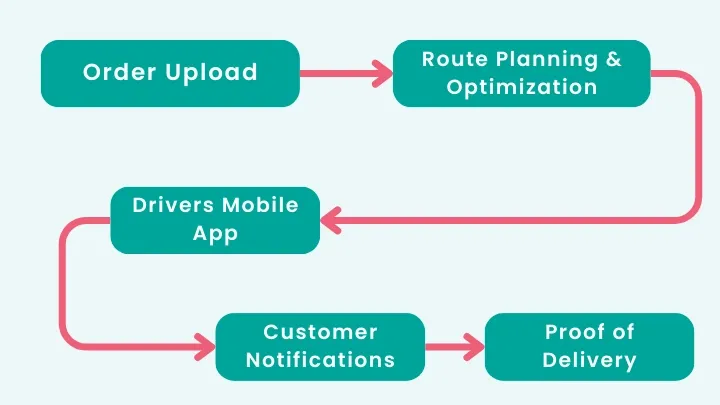
5. Onfleet
Best for: Mid-to-large size fleet operators looking for U.S. support for last mile operations
Onfleet is a feature-rich platform designed for larger fleets and complex logistics operations.
It combines a mobile driver app with a desktop-based management system, offering advanced functionality such as barcode scanning, and route analytics.
While the desktop interface can be slightly complex, showing pins rather than full routes, it provides the depth and flexibility that larger delivery fleets require.
The platform’s capabilities help businesses reduce fuel costs, manage delivery windows, and improve delivery performance, ensuring a better overall customer experience.
Key Features:
- Route Planning: Advanced planning for multiple vehicles, delivery time windows, and vehicle capacity restrictions.
- Mobile Driver App: Provides real-time tracking and turn-by-turn directions for delivery drivers.
- Desktop Management System: Centralized hub to manage fleets, monitor deliveries, and track driver routes.
- Barcode Scanning: Supports scanning parcels for improved accuracy and accountability.
- Analytics and Reporting: Performance dashboards provide insights into delivery efficiency, cost reduction, and operational metrics.
Pricing
Plans start at $500 per month. Onfleet offers a 14-day free trial, but businesses may need to contact the sales team for setup and integration.
At a glance: Onfleet is ideal for mid-to-large fleet operators looking for a robust logistics software solution with advanced features for route optimization, fleet management, and customer communication.
6. Routific
Best for: Small-to-medium sized businesses looking for effective route optimization
Routific is a lightweight yet powerful last mile delivery management platform designed for small and medium-sized businesses.
While it doesn’t include some advanced features like label printing or in-app driver-customer communications, it excels at optimizing delivery routes efficiently and offering a user-friendly interface.
This makes it a reliable tool for businesses that need to streamline delivery operations, reduce fuel costs, and improve delivery performance.
Key Features:
- Route Optimization: Calculates the fastest multi-stop delivery routes to save time, cut fuel costs, and maximize delivery capacity.
- User-Friendly Interface: Simple design ensures easy adoption for dispatchers and drivers, with intuitive mobile driver app functionality.
- Proof of Delivery: Captures electronic signatures, photos, or barcode scanning to reduce disputes and verify deliveries.
- Tracking: Optional real-time tracking provides visibility for dispatchers and customers alike.
Pricing
Subscriptions start at $49 per vehicle per month, increasing to $59 when proof of delivery and tracking are enabled. Additional add-ons are available.
At a glance: Routific is perfect for small to medium-sized businesses that want a simple, reliable last mile logistics software solution.
7. OptimoRoute
Best for: Small-to-medium sized delivery businesses needing advanced customization
OptimoRoute is a robust platform designed for businesses that need more advanced control over their deliveries, including additional features such as depot loading management and vehicle capacity constraints.
These features are particularly useful for businesses managing complex last mile logistics or multi-drop delivery routes.
The desktop interface can feel slightly cluttered compared to newer platforms, but it remains effective for optimizing delivery journeys and reducing delivery delays.
Key Features:
- Route Optimization: Advanced multi-stop planning using AI-driven dispatching and automated route planning algorithms.
- Depot Loading Management: Plan routes efficiently based on depot constraints, schedules, and load sequencing to optimize delivery capacity and reduce handling time.
- Vehicle Capacity Parameters: Factor in vehicle limitations and delivery capacity for higher route accuracy.
- Delivery Management: Assign drivers, monitor progress, and manage schedules effectively.
Pricing
Plans start at $35 per vehicle per month for up to 700 orders, or $44 per month for up to 1,000 orders. Pricing beyond this requires direct consultation with OptimoRoute.
At a glance: OptimoRoute is ideal for small-to-medium businesses that need advanced last mile logistics software for enhanced control over their fleet and multi-drop delivery routes.
8. Route4Me
Best for: Small to medium businesses that need flexible route planning software with advanced features
Route4Me is a flexible solution designed for businesses that want functionality without enterprise-level pricing.
Its core strength lies in routing optimization, though additional features such as curbside pickup, turn preferences, and delivery time windows are available at extra cost.
This makes it a versatile option for small fleets that need both efficiency and flexibility.
Key Features:
- Dynamic Route Planning: Efficient multi-stop routing software for small to medium fleets.
- Flexible Add-Ons: Optional features like time windows, curbside pickup, and left/right turn preferences.
- Mobile App: Allows drivers to view routes and track deliveries in real-time.
- Delivery Management: Track drivers, assign stops, and adjust routes as needed.
Pricing
Starts at $75 per month for one driver with a minimum of 5 users per month that’s a starting price of $375.
At a glance: Route4Me is ideal for smaller businesses that want a cost-effective, customizable solution for last mile logistics and delivery management.
9. Onro
Best for: Businesses looking for value and willing to try a newer solution provider
Onro is an emerging player offering a modern, feature-rich platform that rivals some of the more expensive options.
Their solution is designed to provide core delivery management features while also including value-added tools for businesses looking to streamline operations.
Key Features:
- Route Planning & Optimization: Efficient multi-stop route creation for small to medium fleets.
- Scheduling: Assign and manage delivery windows effectively.
- POD: Capture electronic signatures, photos, and confirmations.
- Enterprise Features: Optional packages include driver app onboarding, invoicing suite, and white labeling.
Pricing: Business package starts at $239 per month, with a cap of 1,500 deliveries. For higher volume or enterprise features, businesses need to contact Onro directly.
At a glance: Onro is a strong option for businesses seeking cost-effective last mile software and are comfortable working with a newer provider.
10. DispatchTrack
Best for: Enterprise fleet managers seeking a full telematics and last mile management platform
DispatchTrack is a well-established provider of comprehensive logistics and fleet management software.
Its platform integrates traditional telematics with last mile delivery tools, offering advanced data analytics, real-time tracking, and automated compliance reporting.
While its last mile-specific features may not be as extensive as some specialized providers, it is ideal for enterprises that want to consolidate fleet management and delivery operations in one platform.
Key Features:
- Intelligent Routing: Plan and optimize routes with advanced analytics.
- Order Tracking: Monitor deliveries in real-time across fleets.
- Customer Communications: Automated notifications and updates for end customers.
- Proof of Delivery: Electronic confirmation and documentation for completed deliveries.
Pricing
Not publicly listed. Interested businesses should contact DispatchTrack for pricing details and setup.
At a glance: DispatchTrack is best suited for enterprise fleets seeking a consolidated platform that combines telematics with delivery tools to improve operational efficiency and reduce costs.
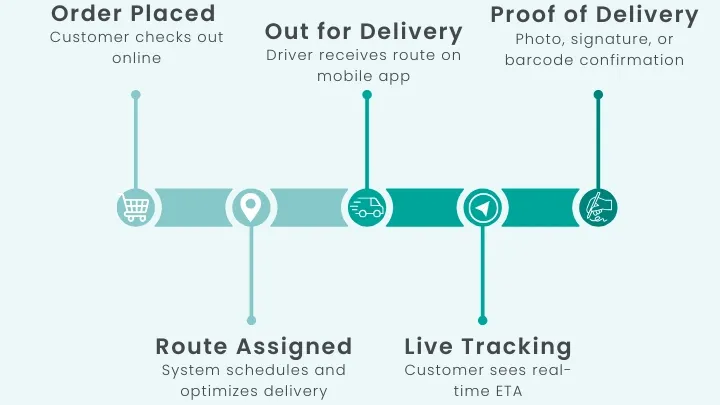
11. TrackPod
Best for: Businesses prioritizing ePOD capabilities
TrackPod began as a proof of delivery solution and has since evolved into a broader delivery platform.
Its strong reputation stems from its advanced POD features, making it a go-to choice for businesses delivering high-value items where disputes are not an option.
Key Features:
- Proof of Delivery: Capture signatures, photos, bills of lading, and delivery notes directly in the mobile app.
- Geotag & Timestamp Confirmation: Adds an extra layer of verification for each delivery.
- Package Scanning: Ensures accuracy by validating parcels before and during delivery.
- Offline Capabilities: Allows drivers to record PODs even in areas without connectivity.
Pricing
Plans start at $29 per month, with flexible options available depending on business size and delivery volume.
At a glance: TrackPod is best for businesses that need advanced proof of delivery functionality alongside reliable route planning and delivery management.
12. Scurri
Best for: Retailers and eCommerce merchants without their own delivery fleet
Scurri is a delivery platform built for retailers and eCommerce brands that rely on third-party carriers.
It integrates with hundreds of last mile carriers, giving businesses instant access to a wide delivery network to improve cost efficiency and speed.
Trusted by brands like Butternut Box, Gousto, and Vision Direct, Scurri helps online retailers strengthen customer satisfaction and retention without the overhead of managing their own fleet.
Key Features:
- Carrier Integrations: Access to a vast network of last mile delivery partners.
- Order Fulfillment: Automates shipping and assigns orders to the best available carrier.
- Delivery Management: Provides tracking, label generation, and reporting across carriers.
- Scalability: Designed for eCommerce businesses with growing order volumes.
Pricing
Not publicly listed. Businesses must contact Scurri for tailored pricing and package options.
At a glance: Scurri is perfect for retailers and eCommerce businesses that want reliable delivery software through third-party carriers without investing in their own fleet.
Final Thoughts on Choosing Last Mile Delivery Software
The last mile has always been one of the most complex and costly parts of the delivery process.
Customers expect fast, reliable service, and businesses face the constant challenge of balancing efficiency with experience.
The right software can make that balance easier to achieve, turning what was once a daily headache into a streamlined, predictable operation.
Across the market, there’s no shortage of options. Some tools keep things simple and affordable, while others cater to larger fleets with advanced customization and integrations.
What matters most is finding a solution that aligns with your delivery volume, your industry, and the level of visibility and control you want.
If you’re weighing up your options, the best way to understand the value of delivery software is to try it for yourself. That’s why SmartRoutes offers a free trial so you can see first-hand how it fits your business and the difference it can make to your day-to-day operations.
FAQ
1. What is last mile delivery software?
Last mile delivery software is a digital platform that helps businesses plan, manage, and track deliveries from the final distribution point to the customer’s doorstep. It typically includes features such as route optimization, real-time tracking, analytics & reporting tools, and automated notifications.
2. How does last mile delivery software reduce costs?
By optimizing delivery routes, reducing fuel consumption, improving driver productivity, and minimizing failed deliveries, last mile software helps businesses save significantly on operational costs.
3. What’s the best route planning system for last mile fleets?
The best system depends on the size and complexity of your fleet. Tools like SmartRoutes, Routific, and OptimoRoute are great for small to medium fleets, while platforms such as Onfleet and DispatchTrack are often better suited for larger, enterprise-level operations that require more customization.
4. Which last mile platforms support driver communication?
Many platforms include built-in driver communication tools. SmartRoutes, Onfleet, and Routific all support messaging features between dispatchers, drivers, and sometimes even customers. This helps reduce delays, avoid confusion, and improve delivery accuracy.
5. How do I choose the best last-mile delivery tracking solution?
Start by assessing what’s most important for your business: real-time visibility, proof of delivery, or customer notifications. For businesses handling high-value items, solutions like TrackPod excel at proof of delivery tracking. For companies that prioritize customer experience, options like SmartRoutes or Scurri (for retailers without fleets) provide strong tracking and communication features.
If you enjoyed this blog, you might also be interested in:
